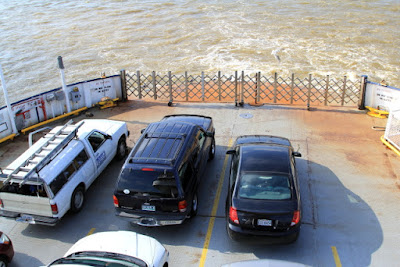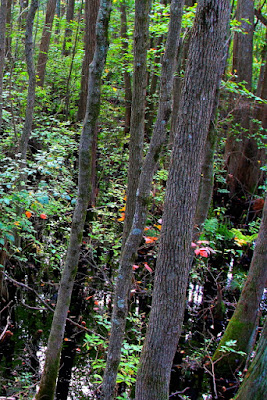 |
| Artist Unknown |
James Fort was the first permanent English settlement in the Americas, established on May 14, 1607 by the Virginia Company of London. It "is where the British Empire began," and served as the capital of the Colony of Virginia for 83 years.
In late 1606 the ships Susan Constant, Discovery, and Godspeed set sail for the Americas and after several stops along the way, they made landfall on the American continent April 26, 1607, at a place they called Cape Henry. However, Cape Henry was not considered to be a secure location; so they sailed up what is now known as the James River for 40 miles to a piece of land located on a large peninsula, landing on May 14, 1607. The peninsula was considered to be a prime location for a fortified settlement because the river channel was defensible due to a curve in the river. Also, and maybe the most important, the land was not inhabited by Indians because the Indians regarded the land as too swampy and remote for growing crops. Unfortunately, the colonists did not realize that the area was plagued by mosquitoes and the brackish tidal river water was unsuitable for drinking.
Since the colonists arrived too late in the year to plant crops, and many of the colonists were gentlemen unaccustomed to manual labor, within a few months about 70% of the party were dead. (Only 60 of the original 214 settlers survived.)
The 1608 supply ships that were sent to the colonists encountered many difficult trials and most of the original settlers died before the ships even arrived at James Fort. However, the ships contained German, Polish, and Slovak craftsmen and the new colonists established the first manufacturing in the colony, of which one of the most successful was glassware.
In 1609 Captain Samuel Argall arrived in the Mary and John with supplies and just in time to prevent the Spanish from attacking and taking over the colony. Also in 1609, the new flagship Sea Venture set sail from England, but ran into a hurricane and the Captain deliberately drove the ship onto the reef in Bermuda so that all of the passengers could make it safely to shore. While stranded on Bermuda for nine months, the survivors built two new ships from the Sea Venture wreckage -- the Deliverance and the Patience.
When the Deliverance and Patience arrived in Jamestown on May 23, 1610, they discovered that most of the colonists were close to death from starvation; so they loaded everyone onto the two ships and decided to return to England. However, as they were sailing down the James River they met relief ships full of supplies and additional settlers, so they turned around and returned to James Fort. The colonists called this "The Day of Providence."
John Rolfe was among the new settlers and he carried with him a new variety of tobacco seeds that adapted very well to the Jamestown area. By 1614, Rolfe was prosperous and wealthy and he married Pocahontas (the daughter of Chief Powhatan), which brought several years of peace between the colonists and the Indians. Rolfe and Pocahontas returned to England on a public relations tour and while there Pocahontas became ill and died on March 21, 1617, ending one of the most infamous periods in American history.
Over the years, the exact location of James Fort was lost and it was assumed that the site had been eroded away and was completely under the James River.
In 1907, the 300th anniversary of English settlement in the New World, a celebration was planned; but since there was no rail service to the peninsula, and most people did not have cars, it was decided to hold a tricentennial "World Fair" celebration about 30 miles downstream at Sewell's Point. The celebration lasted from April 26, 1907 to December 1, 1907 and was attended by President Theodore Roosevelt, Kaiser Wilhelm II (Germany), the Prince of Sweden, Mark Twain, and many other dignitaries and famous people. The Jamestown Tercentenary Monument is now located just outside of the James Fort location.


For the 350th anniversary (1957), a celebration was held on the peninsula and three full-sized replicas of the sailing ships Susan Constant, Godspeed, and Discovery were constructed and placed on display at a new dock that was constructed at the James Fort site. Other improvements consisted of a reconstructed Glasshouse, the Memorial Cross, a visitor's center, and a new loop road around the island. The celebration lasted from April 1 to November 30, 1957 and was attended by Vice President Richard Nixon, Queen Elizabeth II and Prince Philip, and many other dignitaries and special guests. Queen Elizabeth II also loaned the United States a copy of the Magna Carta for the exhibition. While the exhibit was open, over a million people visited the site.
Then, in 1994, an archaeologist working at the site discovered remains of the original fort, which everyone had assumed was under the James River. Excavation of the site is still ongoing and over two million artifacts have been found, many of which are on display in an archaeological museum called the Archaerium. Apparently, only part of the fort location was eroded away.
The 400-year celebration of Fort James was held on May 4, 2007 and was once again attended by Queen Elizabeth II and Prince Phillip, plus numerous dignitaries and other guests.
A statue of John Smith overlooks the James River and a partial reconstructed church and other exhibits are located on the site. There are many crosses on the site representing burial sites of the early colonists.
 |
| Artist Unknown |
The historic Memorial Church has been partially restored and is open to visitors.
At the reconstructed Glasshouse, artisans demonstrate how glass items were made by the colonists and their works are for sale in the gift shop.
 |
| Photographer Unknown |
It is possible to cross a wooden bridge and follow Island Drive (one-way loop road) to Black Point and around the island. The road passes a Pitch and Tar Swamp, Confederated troop camp sites, Tidewater plants, flowers, tall trees, meadows, and various eagle nesting places.



















































































